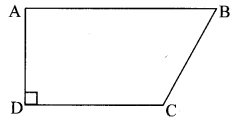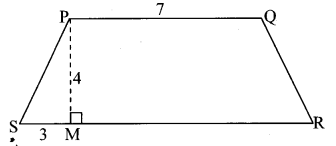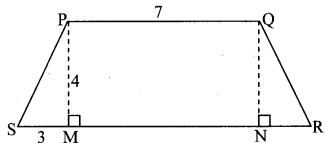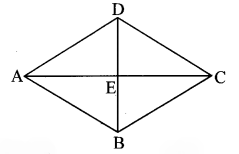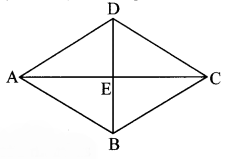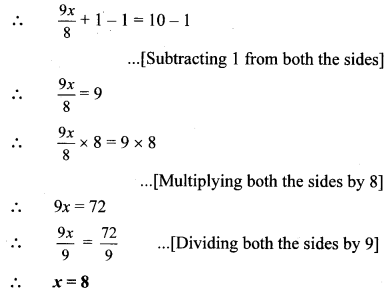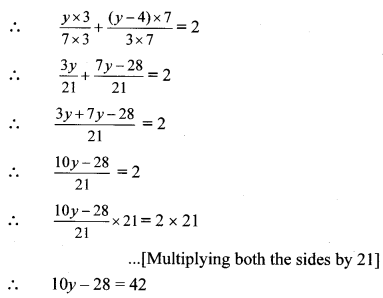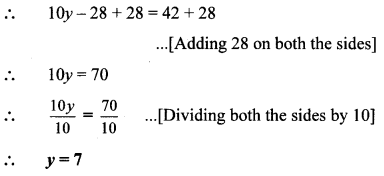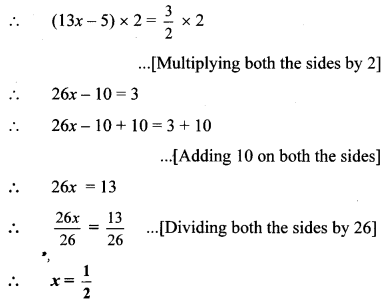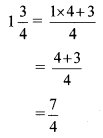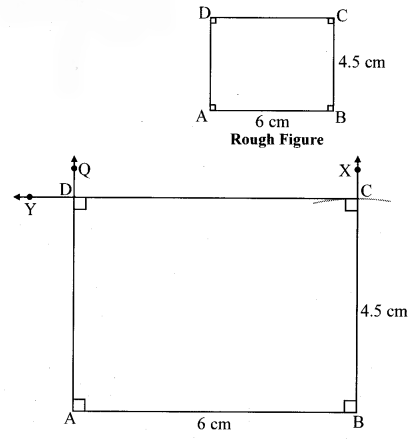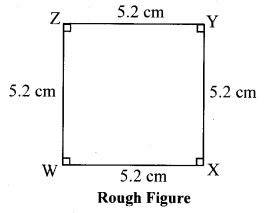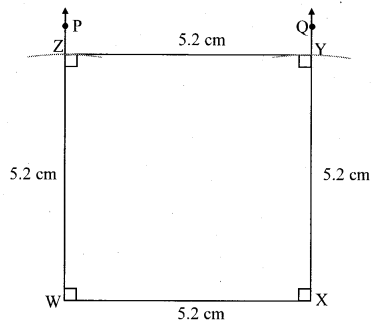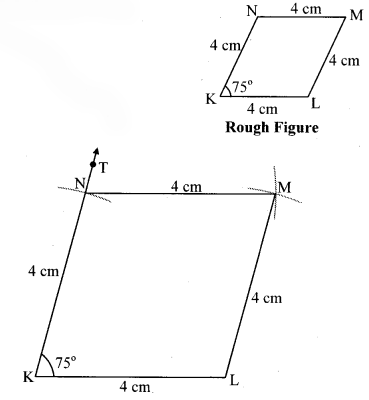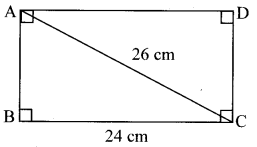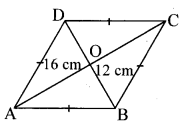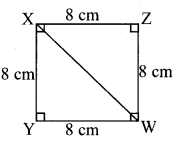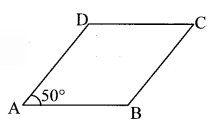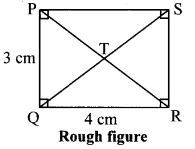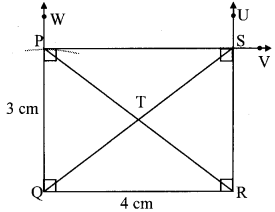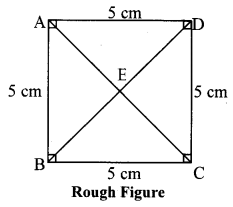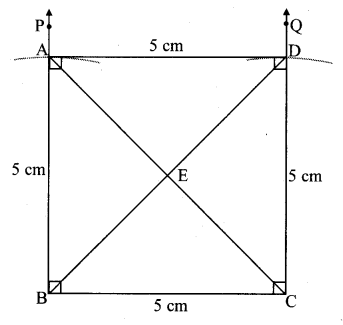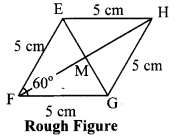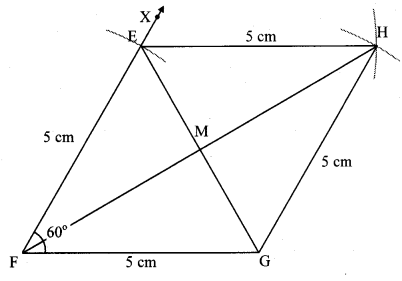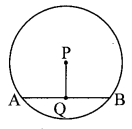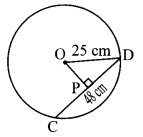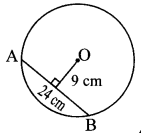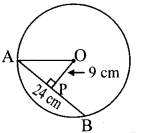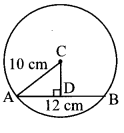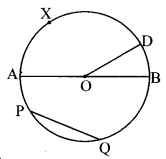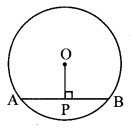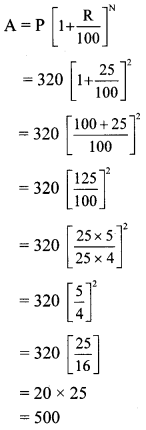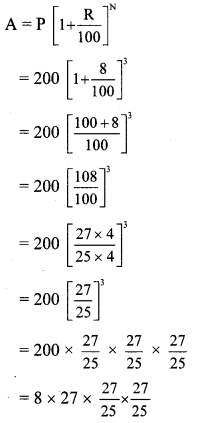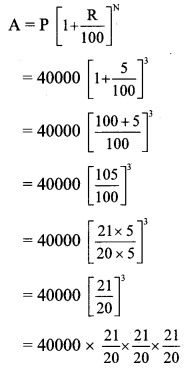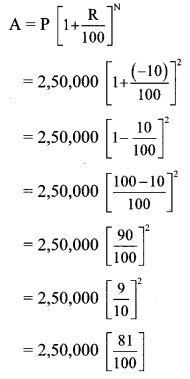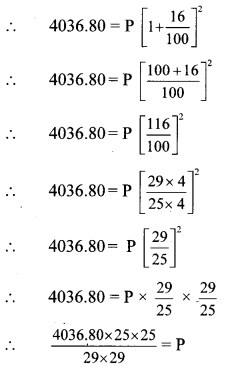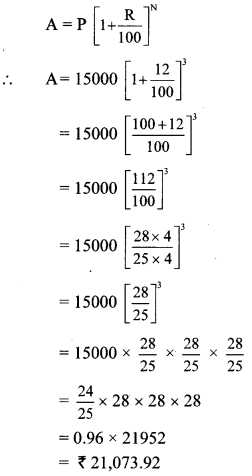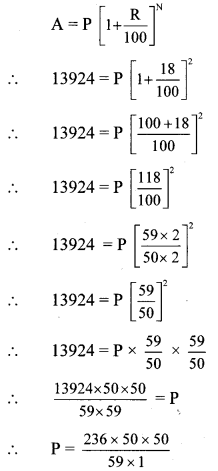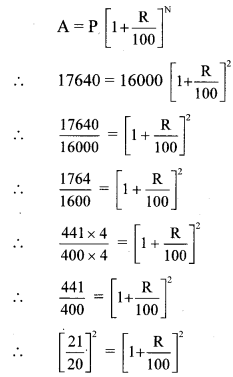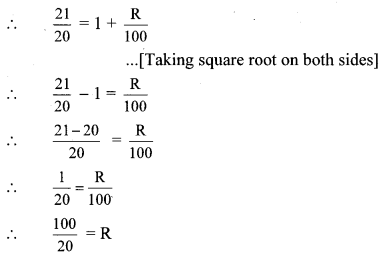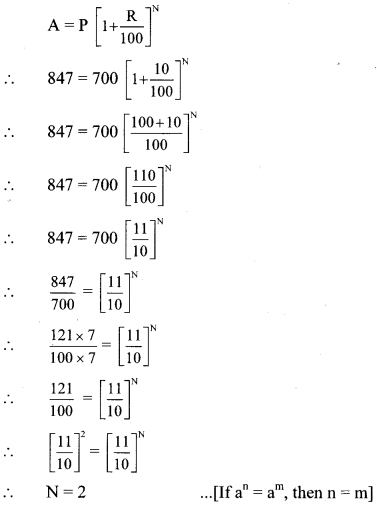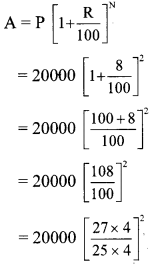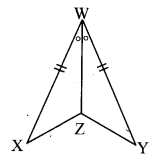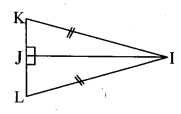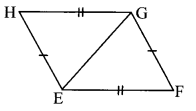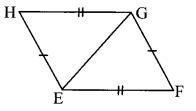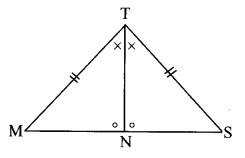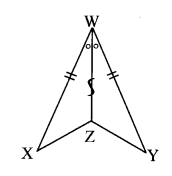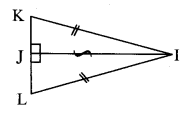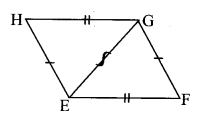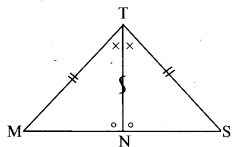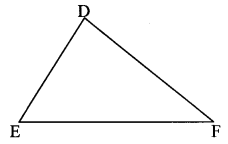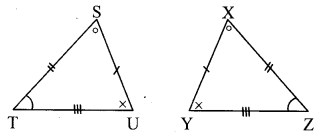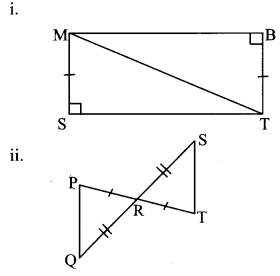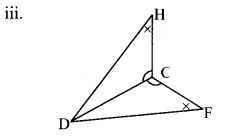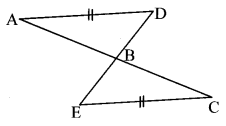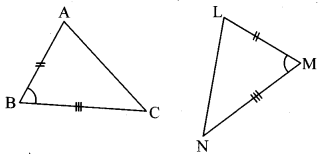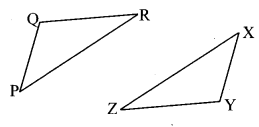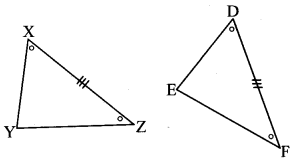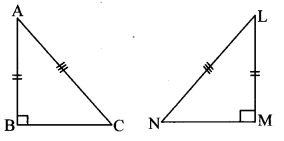Balbharti Maharashtra State Board Class 8 Marathi Solutions Sulabhbharati Chapter 4 आपण सारे एक Notes, Textbook Exercise Important Questions and Answers.
Maharashtra State Board Class 8 Marathi Solutions Chapter 4 आपण सारे एक
Marathi Sulabhbharti Class 8 Solutions Chapter 4 आपण सारे एक Textbook Questions and Answers
1. एका शब्दांत उत्तरे लिहा.
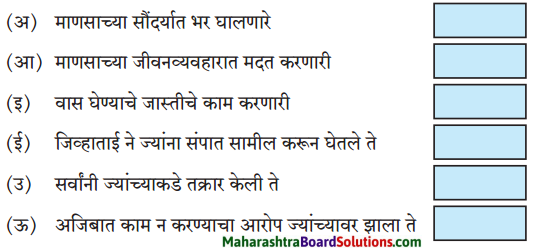
प्रश्न 1.
एका शब्दांत उत्तरे लिहा.

उत्तर:
(अ) माणसाच्या सौंदर्यात भर घालणारे – [नयनकुमार]
(आ) माणसाच्या जीवनव्यवहारात मदत करणारी- [कर्णिका]
(इ) वास घेण्याचे जास्तीचे काम करणारी – [नासिका]
(ई) जिव्हाताई यांना संपात सामील करून घेणारे – [दंतराज]
(उ) सर्वांनी ज्यांच्याकडे तक्रार केली ते – [मेंदूराजे]
(ऊ) अजिबात काम न करण्याचा आरोप असणारे – [पोटोबा]

2. आकृती पूर्ण करा.
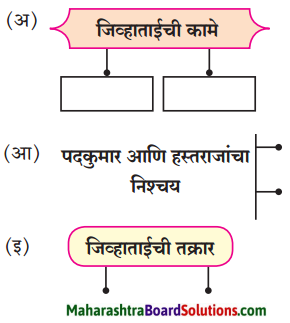
प्रश्न 1.
आकृती पूर्ण करा.

उत्तर:
अ.
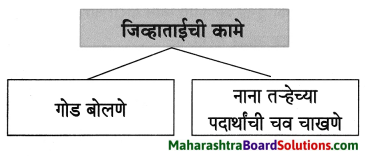
आ.

इ.

3. कारणे शोधा व लिहा.
अ. जिव्हाताई गप्प आहे, कारण…………………..
आ. पोटोबा मधून मधून गुरगुरतो, कारण ……………..
प्रश्न 1.
अ. जिव्हाताई गप्प आहे, कारण…………………..
आ. पोटोबा मधून मधून गुरगुरतो, कारण ……………..
उत्तर:
अ. जिव्हाताई गप्प आहे, कारण पोटोबा खवय्येची मोठी चीड यायला लागली आहे म्हणून.
आ. पोटोबा मधून मधून गुरगुरतो, कारण त्याला गुरगुरण्याची सवय आहे.
4. स्वमत स्पष्ट करा.
प्रश्न अ.
‘आपण सगळे शरीररूपी राज्याचे सेवक आहोत’ या विधानाबाबत तुमचे मत.
उत्तरः
उतारा 3 मधील ‘कृती 4 – स्वमत’ चे उत्तर पहा.
प्रश्न आ.
पोटाबद्दलची तक्रार सांगून सर्व इंद्रियांनी ती तक्रार करण्याची कारणे.
उत्तरः
उतारा 2 मधील ‘कृती 4 – स्वमत’ चे उत्तर पहा.
खेळूया शब्दांशी.
(अ) खालील वाक्यात योग्य विरामचिन्हे घाला.
प्रश्न अ.
तो म्हणेल तेवढचं खायची सक्ती असते माझ्यावर
उत्तर:
“तो म्हणेल तेवढचं खायची सक्ती असते माझ्यावर!”

प्रश्न आ.
हो हो आमची तयारी आहे
उत्तर:
“हो, हो आमची तयारी आहे.”
(आ) वर्गीकरण करुन तक्ता पूर्ण करा.
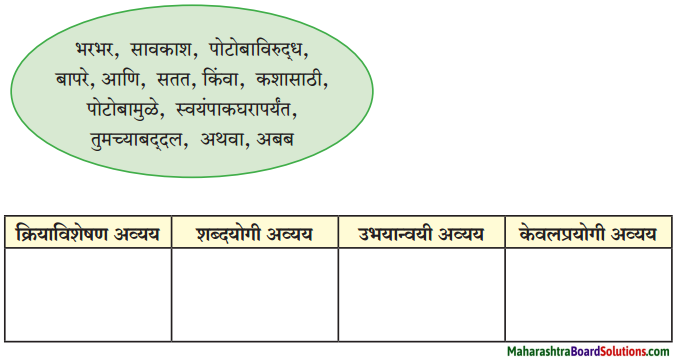
प्रश्न 1.
भराभर, सावकाश, पोटोबाविरुद्ध, बापरे, आणि, सतत, किंवा, कशासाठी, पोटोबामुळे, स्वयंपाकघरापर्यंत, तुमच्याबद्दल, अथवा, अबब
उत्तर:
| क्रियाविशेषण अव्यय |
शब्दयोगी अव्यय |
उभयान्वयी अव्यय |
केवलप्रयोगी अव्यय |
भरभर,
सावकाश,
सतत |
पोटाबाविरुद्ध,
कशासाठी,
पोटोबामुळे,
स्वयंपाक
घरापर्यंत,
तुमच्याबद्दल |
आणि, किंवा, बापरे, अबब अथवा
|
बापरे, अबब |

(इ) खालील शब्दांसाठी पाठात वापरलेले शब्द लिहा.
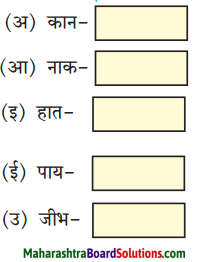
प्रश्न 1.
खालील शब्दांसाठी पाठात वापरलेले शब्द लिहा.

उत्तर:
(अ) कान – [कर्णिका]
(आ) नाक – [नासिका]
(इ) हात – [हस्तकराज]
(ई) पाय – [पदकुमार]
(उ) जीभ – [जिव्हाताई]
उपक्रम :
1. ‘आधी पोटोबा मग विठोबा’ ही, म्हण या पाठात आली आहे. याप्रमाणे शरीर अवयवांशी संबंधित असणाऱ्या इतर म्हणी शोधा व लिहा.
2. या पाठाचे नाट्यीकरण वर्गात सादर करा.

Marathi Sulabhbharti Class 8 Solutions Chapter 4 आपण सारे एक Important Additional Questions and Answers
पुढील उताऱ्याच्या आधारे दिलेल्या सूचनेनुसार कृती करा.
कृती 1 : आकलन कृती
प्रश्न 1.
खालील कृती पूर्ण करा.
उत्तर:
i.

ii.

प्रश्न 2.
चौकटी पूर्ण करा.
उत्तर:
i.

ii.
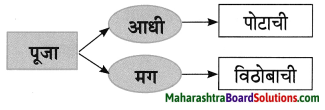
प्रश्न 3.
जोड्या जुळवा.
‘अ’ गट
(नाटिकेतील नावे) |
‘ब’ गट
(अवयवांची नावे) |
| 1. नासिका |
(अ) डोळे |
| 2. कर्णिका |
(आ) जीभ |
| 3. नयनकुमार |
(इ) पाय |
| 4. जिव्हाताई |
(ई) नाक |
| 5. हस्तकराज |
(उ) कान |
| 6. पदकुमार |
(ऊ) हात |
उत्तर:
‘अ’ गट
(नाटिकेतील नावे) |
‘ब’ गट
(अवयवांची नावे) |
| 1. नासिका |
(ई) नाक |
| 2. कर्णिका |
(उ) कान |
| 3. नयनकुमार |
(अ) डोळे |
| 4. जिव्हाताई |
(आ) जीभ |
| 5. हस्तकराज |
(ऊ) हात |
| 6. पदकुमार |
(इ) पाय |

प्रश्न 4.
वेब पूर्ण करा.
उत्तर:

प्रश्न 5.
असे कोण कोणास म्हणाले ते लिहा.
- “या! या!! रामराव, आज स्वारी कशी आली इकडे?”
- “अरे, अरे, एका दमात किती प्रश्न विचारता शामराव?”
उत्तर:
- असे शामराव रामरावांना म्हणाले.
- असे रामराव शामरावांना म्हणाले.

कृती 2 : आकलन कृती
प्रश्न 1.
खालील कृती पूर्ण करा.
उत्तर:
(i)

(ii)

प्रश्न 2.
एका शब्दात उत्तरे लिहा.
उत्तर:
- पोटोबाची चीड येणारी – [जिव्हाताई]
- पोटोबाला दिलेली उपमा – [खवय्या]
- मानसन्मान याला मिळतो – [पोटोबा]
- सारी धडपड कशासाठी – [पोटासाठी]
- त्या पोटोबामुळे आपली होते – [फरफट]

प्रश्न 3.
आकृतिबंध पूर्ण करा.
उत्तर:
i.
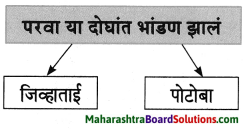
ii.

iii.
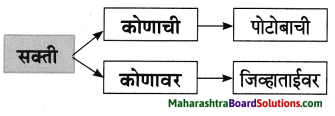
प्रश्न 4.
खालील वेब पूर्ण करा.
उत्तर:
i.
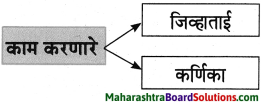
ii.

कृती 3: व्याकरण कृती
प्रश्न 1.
खालील वाक्यातील विरामचिन्हे ओळखून त्यांची नावे लिहा. अरे, अरे, एका दमात किती प्रश्न विचारता शामराव ?
उत्तरः
| विरामचिन्हे |
विरामचिन्हाचे नाव |
| (,) |
स्वल्पविराम |
| (?) |
प्रश्नचिन्ह |
प्रश्न 2.
खालील वाक्यांत योग्य विरामचिन्हे वापरुन वाक्य पुन्हा लिहा.
- या या शामराव आज स्वारी कशी आली इकडे
- चला चला कामाचं बघू नंतर आधी पोटोबा मग विठोबा
उत्तर:
- “या! या!! शामराव, आज स्वारी कशी आली इकडे?”
- “चला, चला, कामाचं बघू नंतर. आधी पोटोबा, मग विठोबा.”

प्रश्न 3.
खालील शब्दांचे लिंग बदलून लिहा.
- बाबा
- कुमार
- ताई
- बाई
- तो
उत्तर:
- आई
- कुमारी
- दादा
- पुरुष
- ती
प्रश्न 4.
खालील वाक्यांचे प्रकार ओळखून लिहा.
- काय सांगू बाई!
- आज स्वारी कशी आली इकडे ?
उत्तर:
- उद्गारार्थी वाक्य
- प्रश्नार्थी वाक्य
कृती 4 : स्वमत
प्रश्न 1.
‘आधी पोटोबा मग विठोबा’ ही म्हण या पाठात आली आहे. याप्रमाणे शरीर अवयवांशी संबंधित असणाऱ्या इतर म्हणी लिहा. (विदयार्थी यापेक्षा वेगळ्या म्हणी लिहू शकतात.)
उत्तर:
- हातच्या कंकणाला आरसा कशाला?
- कानामागून आली अन् तिखट झाली.
- अंथरुण पाहून पाय पसरावेत.
- आठ हात लाकूड, नऊ हात ढलपी.
- आपला हात जगन्नाथ,
- आपले नाक कापून दुसऱ्याला अपशकुन.

पुढील उताऱ्याच्या आधारे दिलेल्या सूचनेनुसार कृती करा
कृती 1 : आकलन कृती
प्रश्न 1.
आकृतिबंध पूर्ण करा.
उत्तर:
i.

ii.
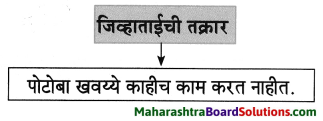
iii.
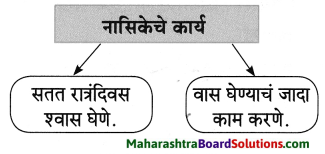
iv.
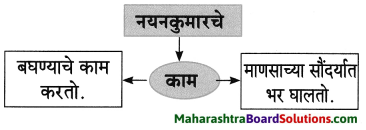
प्रश्न 2.
खालील चौकटी पूर्ण करा.
उत्तर:
- माणसाच्या जीवनव्यवहाराला मदत करणारी – [कर्णिका]
- माणसाला श्वासाशिवाय जगू न देणारी – [नासिका]
- माणसांच्या जीवनाला अर्थ देणारी – [जिव्हाताई]

कृती 2 : आकलन कृती
प्रश्न 2.
खालील वेब पूर्ण करा.
उत्तर:
i.

ii.
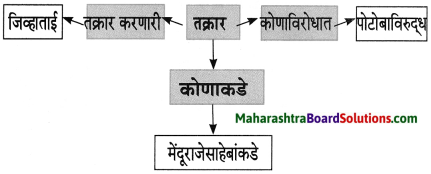
iii.
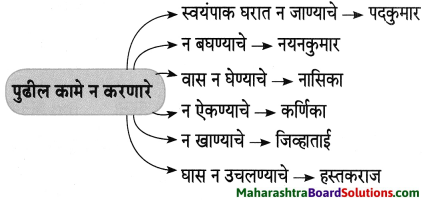
प्रश्न 2.
एका वाक्यात उत्तरे लिहा.
प्रश्न i.
सर्व अवयव कोणाविरुद्ध संप करणार आहेत?
उत्तर:
सर्व अवयव पोटोबाविरुद्ध संप करणार आहेत.
प्रश्न ii.
नाना तहेची चव मानव कोणामुळे चाखू शकतो?
उत्तर:
नाना त-हेची चव मानव जिव्हाताईमुळे चाखू शकतो.

प्रश्न 3.
कंसात दिलेल्या पर्यायांपैकी योग्य पर्याय निवडून रिकाम्या जागा भरा.
- जो उठतो तो, ‘कशासाठी? पोटासाठी’, म्हणत आम्हांला ………………….. घेतो. (बजावून, राबवून, दामटवून, धाकात)
- म्हणजे मग त्या पोटोबाला चांगलीच ………………………. घडेल. (शक्कल, नक्कल, अक्कल, अद्दल)
उत्तर:
- राबवून
- अद्दल
कृती 3: व्याकरण कृती
प्रश्न 1.
खालील वाक्यांतील अव्यये ओळखून लिहा.
i. श्वास घेतल्याशिवाय माणूस जगू शकेल का?
ii. तिचं म्हणणं आहे, की पोटोबा खवय्ये काहीच काम करत नाहीत.
उत्तर:
i. शिवाय
ii. की
प्रश्न 2.
खालील वाक्प्रचारांचा अर्थ सांगून वाक्यात उपयोग करा.
उत्तर:
1. राबवून घेणे – दुसऱ्यांकडून जबरदस्तीने काम करून घेणे.
वाक्य : मालक नोकरांना राबवून घेतात.
2. अद्दल घडणे – शिक्षा होणे, कानउघडणी होणे.
वाक्यः सतत खात राहणाऱ्या दादाला आज काहीच खाण्यास न मिळाल्याने चांगलीच अद्दल घडली.

प्रश्न 3.
खालील वाक्यांतील क्रियाविशेषण अव्यये शोधून लिहा.
- अगं ही बडबडी, पोटाबद्दल तक्रार करतीय.
- रात्रंदिवस श्वास घेण्याचं कार्य सतत चालूच असतं.
- मी नेहमी बघण्याचं काम करतो.
- आपण सारेजण अनेक कामे करतो.
उत्तर:
- बडबडी
- सतत
- नेहमी
- अनेक
प्रश्न 4.
खालील शब्दांना ‘यात’ प्रत्यय जोडून शब्द पुन्हा लिहा.
- म्हणणे
- बोलणे
- माझं
- गुरगुरणे
- सौंदर्य
- ऐकणे
- तुझा
- जगणे
- खाणारे
- घरटे
- देणे
- विचारणे
उत्तर:
- म्हणण्यात
- बोलण्यात
- माझ्यात
- गुरगुरण्यात
- सौंदर्यात
- ऐकण्यात
- तुझ्यात
- जगण्यात
- खाणाऱ्यात
- घरट्यात
- देण्यात
- विचारण्यात

प्रश्न 5.
खालील वाक्यांतील अधोरेखित शब्दांची जात ओळखा.
- मी नेहमी बघण्याचं काम करतो.
- आमची तयारी आहे संप करण्याची.
- माणसाच्या सौंदर्यात भर घालतो, तो मीच.
- पोटोबा मात्र आयते बसून खातात.
उत्तर:
- मी – सर्वनाम, काम – नाम
- आमची – सर्वनाम, संप – नाम
- माणूस – नाम, मी – सर्वनाम
- पोटोबा – नाम, आयते – विशेषण
कृती 4 : स्वमत
प्रश्न 1.
पोटोबाबद्दलची तक्रार सांगून सर्व इंद्रियांनी ती तक्रार करण्याची कारणे सांगा.
उत्तरः
‘पोटोबा हे फक्त खवय्ये आहेत ते काहीच काम करत नाहीत उलट सर्वांवर गुरगुरतात’ अशी सर्व इंद्रियांची तक्रार आहे. कारण प्रत्येक इंद्रिय काही ना काही काम करत आहे. नासिका रात्रंदिवस श्वास घेण्याचं कार्य करते. नयनकुमार सतत बघण्याचं काम करतात, तसेच माणसाच्या सौंदर्यात भर घालण्याचे काम करतात. कर्णिका ऐकण्याचं काम करते. जिव्हाताईमुळे माणसाच्या जीवनात अर्थ आहे. ती गोड बोलते, नाना त-हेच्या पदार्थांची चव चाखते. यांपैकी पोटोबा कोणतेच काम करत नसल्याने व सर्वांवर फक्त गुरगुरण्याचे काम करत असल्याने सर्व मेंदूराजेसाहेबांकडे तक्रार करणार आहेत.

पुढील उताऱ्याच्या आधारे दिलेल्या सूचनेनुसार कृती करा.
कृती 1: आकलन कृती
प्रश्न 1.
चौकटी पूर्ण करा.
उत्तरः
- सर्वजण मेंदूराजाकडे जाताच – [मेंदूराजे तातडीने सभा घेतात.]
- जीवनरस न मिळाल्याने – [सर्वांचे चेहरे सुकून गेले.]
- पोटोबांनी खोटं ठरवलेली तक्रार – [मी काम करत नाही.]
प्रश्न 2.
कोण ते लिहा.
उत्तरः
- मेंदूराजांचा जयजयकार करणारे – [सर्वजण]
- सर्वांना बसायला सांगणारे – [मेंदूराजे]
- पोटोबांना दिलेली उपाधी – [प्रधान गुरगुरणे]
- पोटोबांना ‘प्रधान’ बोलणारे – [मेंदूराजे]
- केव्हाच हजर झालेले – [पोटोबा]

प्रश्न 3.
खालील वेब पूर्ण करा.
उत्तरः
i.

ii.
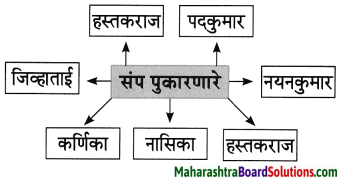
iii.

कृती 2 : आकलन कृती
प्रश्न 1.
पुढील कृती पूर्ण करा.
i.

ii.

प्रश्न 2.
एका वाक्यात उत्तरे लिहा.
प्रश्न i.
सर्व इंद्रियांनी कोणाचा जयजयकार केला?
उत्तरः
सर्व इंद्रियांनी मेंदूराजेसाहेबांचा जयजयकार केला.

प्रश्न ii.
पोटोबा ‘महाराज’ असा उल्लेख कोणाचा करतात?
उत्तर:
पोटोबा ‘महाराज’ असा उल्लेख ‘मेंदूराजेसाहेबांचा’ करतात.
प्रश्न 3.
आकृतिबंध पूर्ण करा.
i.

ii.

iii.

कृती 3 : व्याकरण कृती
प्रश्न 1.
खालील शब्दांचे विरुद्धार्थी शब्द लिहा.
- बसा
- हजर
- खोटं
- सेवक
उत्तर:
- उठा
- गैरहजर
- खरं
- मालक

प्रश्न 2.
खालील वाक्यांतील अधोरेखित शब्दांचे विरोधी शब्द वापरून वाक्ये पुन्हा लिहा.
प्रश्न i.
मी केव्हाच हजर आहे महाराज.
उत्तर:
मी कधीच गैरहजर नसतो महाराज.
प्रश्न ii.
आपण सारेच या शरीररूपी राज्याचे सेवक आहोत.
उत्तर:
आपण सारेच या शरीररूपी राज्याचे मालक आहोत.

प्रश्न 3.
खालील वाक्यांतील अधोरेखित शब्दांचे वचन बदलून वाक्ये पुन्हा लिहा.
प्रश्न i.
जीवनरस मिळाला नाही म्हणून त्यांचे चेहरे बघा कसे सुकून गेलेत.
उत्तरः
जीवनरस मिळाला नाही म्हणून त्यांचा चेहरा बघा कसा सुकून गेलाय.
प्रश्न ii.
ती माझी सवय आहे.
उत्तर:
त्या माझ्या सवयी आहेत.

प्रश्न 4.
खालील वाक्यांत विरामचिन्हांचा वापर करून वाक्य पुन्हा लिहा.
प्रश्न i.
पोटोबा या सर्व मंडळींची तुमच्याबद्दल तक्रार आहे की तुम्ही अजिबात काम करत नाही.
उत्तर:
“पोटोबा, या सर्व मंडळींची तुमच्याबद्दल तक्रार आहे, की तुम्ही अजिबात काम करत नाही.”
प्रश्न ii.
आपण सारे एक आपण सारे एक.
उत्तर:
आपण सारे एक! आपण सारे एक!!
प्रश्न 5.
खालील वाक्यांतील वाक्प्रचार ओळखून लिहा.
प्रश्न i.
महाराज बोलताना जरा बेअदबी होतेय,
उत्तर:
बेअदबी होणे.

प्रश्न ii.
आता आम्ही तुमच्याविषयी कधीही कुरकुर करणार नाही.
उत्तर:
कुरकुर करणे.
कृती 4 : स्वमत
प्रश्न 1.
‘आपण सारे शरीररूपी राज्याचे सेवक आहोत’ या विधानाबाबत तुमचे मत स्पष्ट करा.
उत्तरः
आपले शरीर ही एक संस्था आहे. या संस्थेतील सर्व इंद्रिये एकमेकांवर अवलंबून आहेत. प्रत्येकाचे काम वेगवेगळे आहे. प्रत्येकाने केलेल्या कार्यावर आपले शरीर चालते. पण प्रत्येक इंद्रियाचे कार्य करण्यास लागणारी ऊर्जा ही अन्नाद्वारे मिळते. आपणास भूक लागली की आपण जेवतो, जेवल्यानंतर पोटातील अन्नावर प्रक्रिया होऊन त्याचे रूपांतर ऊर्जेत होऊन त्यावर वेगवेगळी इंद्रिये चालतात व शरीराचे काम चालते.
ज्याप्रमाणे राज्याचा राजा असेल तरच राज्याचे कार्य वेगवेगळ्या अधिकाऱ्यांकडून केले जाते. त्याचप्रमाणे पोटाला भूक लागली की आपण जेवतो. जेवल्यावर अन्नाच्या रूपाने प्रत्येक इंद्रियांना ऊर्जा मिळून शरीराचे कार्य चालते. पोटाला भूकच नाही लागली, आपण जेवलोच नाही, तर कार्य होण्यास लागणारी ऊर्जा न मिळाल्याने शरीराचे कार्य चालणारच नाही. म्हणूनच म्हणावेसे वाटते की, सर्व इंद्रिये ही साऱ्या शरीररूपी राज्याचे सेवक आहेत.
आपण सारे एक Summary in Marathi
पाठपरिचय :
आपले शरीर ही एक परिसंस्था आहे. त्यातील सर्व इंद्रिये या परिसंस्थेचे घटक आहेत. ही सर्व इंद्रिये आपले स्वत:चे नेमून दिलेले काम चोख करत असतात. या सर्व इंद्रियांवर आपले शरीर चालते. या शरीररूपी राज्यातील ही सर्वच इंद्रिये परस्परांना अनुकूल व महत्त्वाची असतात. या सर्व इंद्रियांनी परस्परांची काळजी घेतली तर आरोग्य कसे उत्तम राहते, हे या छोट्या नाटिकेतून सहज सोप्या शब्दांतून लेखिकेने पटवून दिले आहे. पर्यायाने आपले कुटुंब, परिसर, देश यांच्यासाठी हा पाठ एकात्मतेचा संदेश देतो.
Our whole body is an organisation and organs are its elements. All organs function properly. Our body works because of these organs. All organs are very important. If all organs work hand in hand and take care of each other then health will be perfect, this message has been given through this play. Ultimately the message that has been given is for unity of family, locality & Nation.

शब्दार्थ :
- फेरी – फेरफटका, प्रदक्षिणा – a round, a trip
- दम – श्वास, धाप – breath, gasping
- फिरस्ती – प्रवास – travel
- अवयव – शरीराचे भाग – body part
- गमतीदार – मनोरंजक, मजेशीर – funny, joyous
- संवाद – संभाषण – conversation
- उदास – खिन्न, निराश – gloomy, sad
- सारी – सर्व – all
- धडपड – खटपट, जोरदार – struggle
- प्रयत्न सक्ती – जबरदस्ती, जुलूम – compulsion
- गुरगुरणे – (पोटात) गुरगुर आवाज होणे – to rumble (in the belly)
- खवय्ये – खाणारे, खादाड – very greedy
- कार्य – काम – work
- राबवणे – एखादयाकडून – to force selfishly
- जबरदस्तीने काम a person to work
- करून घेणे – hard
- नाना – वेगवेगळ्या – different
- चाखणे – चव घेणे, आस्वाद घेणे – to test
- दंत – दात – tooth
- बेअदबी – अपमान – disrespect, insuct
- कसूर – निष्काळजीपणा – negligence
वाक्प्रचार :
- पोटोबाची पूजा करणे – खाणे, जेवणे
- पोटासाठी वणवण हिंडणे – अन्न मिळवण्यासाठी कष्ट करणे
- फरफट होणे – गैरसोय होणे राबवून घेणे – दुसऱ्याकडून जबरदस्तीने काम
- करवून घेणे आयते बसून खाणे – काही काम न करता बसून खाणे
- अद्दल घडणे – शिक्षा होणे बेअदबी होणे – अवमान होणे
- कसूर माफ करणे – गुन्हा माफ करणे
- कुरकुर करणे – तक्रार करणे
टिपा :
- आधी पोटोबा, मग विठोबा (एक म्हण) – प्रथम भूक लागली म्हणून जेवणे व नंतर देवाची पूजा करणे.
- संप – अधिक मजुरी, अधिक सवलती मिळवण्यासाठी किंवा अन्यायाविरुद्ध कर्मचारी वर्गाने पुकारलेले कामबंद आंदोलन.
